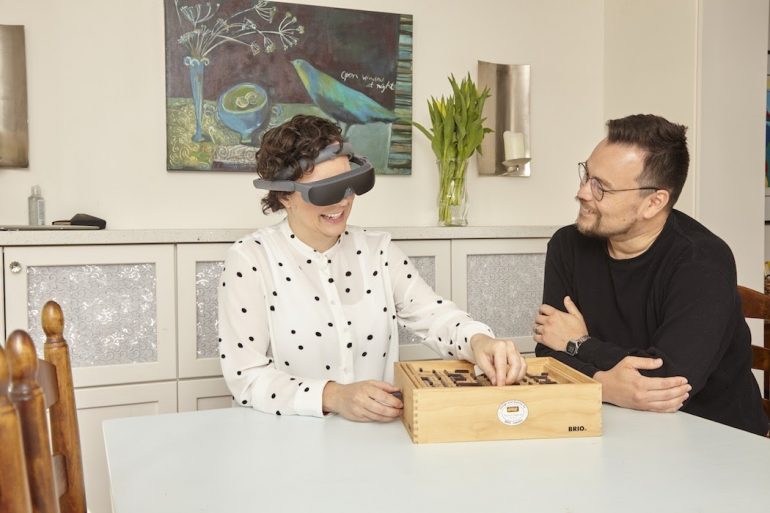Electronic glasses company eSight has launched eSight 4, the newest version of its wearable assistive device designed to enhance vision for those who are living with eye disease and disorders that lead to low vision and legal blindness.
“While the technology continues to advance, our mission remains the same.”
New features of the wireless, hands-free device include improved auto-focus, advanced controls such as zoom, focus, and contrast, and two high-resolution screens for full binocular vision that integrate with the user’s prescription lenses.
eSight told BetaKit it has been actively working on eSight 4 for two years, after conducting research with both users of eSight 3, and low vision experts to develop hardware and software to build upon its existing offering.
“eSight launched as an unbelievable breakthrough in technology, and has since moved to a clinically validated solution for people living with eye disease and disorders that’s widely acclaimed by leading low vision medical professionals,” said Robert Vaters, eSight’s CEO and president. “While the technology continues to advance, our mission remains the same: to create a more inclusive world and empower the low vision community to see new possibilities.”
The launch comes three months after eSight appointed Vaters as its president and CEO. Vaters replaced Kevin Banderk, who joined eSight in January 2019 as chief commercial officer and was named CEO in May 2019. Banderk departed the role less than six months laterrto serve as chief marketing officer and chief revenue officer at Toronto-based Ecobee.
RELATED: eSight, CNIB partnership to expand public access to smart glasses for the visually impaired
eSight 3, launched in 2017, used high-resolution screens, smart algorithms, and a camera to help a low vision individual see more clearly. At the beginning of 2019, eSight lowered the price of its glasses by 40 percent, from $12,500 CAD to $8,000 CAD. Speaking with BetaKit in April, Vaters acknowledged that development costs are expensive, and that finding the right price is a work in progress.
“While the uncertainty of COVID-19 impacts everyone, those with visual impairments are experiencing this differently.”
Since the launch of eSight 3, the company claimed it has experienced substantial business growth, which enabled the price reduction. The company said last year that the 40 percent price reduction would also empower more public and private institutions to cover the cost of eSight for low-vision stakeholders, allowing the technology to be granted through employee benefit programs and standardized accessibility offerings.
eSight has remained operational since the onset of the COVID-19 pandemic, and moved its employees from an open space office to a work from home format. According to the company, it continued to produce its glasses and fulfill orders.
“While the uncertainty of COVID-19 impacts everyone, those with visual impairments are experiencing this differently,” Vaters wrote in a blog post in April. “It’s now time for us to come together to help solve some of the complex issues people with low vision are facing.”
He said those with vision impairments generally rely on touch as their guiding sense, which they can no longer use due to social distancing measures. A recent survey from the Canadian Council of the Blind indicated the visually-impaired community is facing unique challenges due to the pandemic, including mental health concerns, social isolation, and fears that police or bylaw officers may not realize they’re blind.
During the crisis, eSight launched #eSightTogether, an online resource for the low vision community as they learn to navigate through their new aspects of daily living amid the COVID-19 outbreak.
RELATED: Fable Tech Labs raises $2 million seed round to bring accessibility to digital products
The resource contains a list of the most pertinent resources for people with visual impairments to stay informed with COVID-19 and access useful tools for managing during this stressful time.
The company also launched eSight Workplace, a COVID-19 program providing an electronic vision device that brings an organization’s remotely accessible technology into the employee’s device screen that they can see and control. The initiative was aimed to help low-vision employees remain productive during the crisis.
The tools include curated low vision resources, at-home entertainment, educational materials, and apps ideal for social distancing. The new offering is aimed to provide a sense of community to those living with vision loss.
In April, Vaters told BetaKit that eSight is currently in the early stages of raising an additional round of capital. The company has since confirmed to BetaKit it is in the process of raising a $15 million convertible debenture from insider investors. eSight said the round is intended to be a bridge to support operations surrounding the domestic and international launches of eSight 4. The startup’s last funding was a $10 million debenture round led by iGan Partners in May 2019, and the company confirmed it intends to raise a Series B round in 2021.
Image courtesy eSight.

